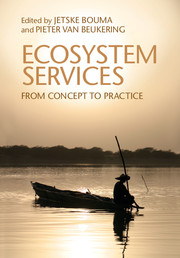Book contents
- Frontmatter
- Contents
- About the authors
- Part I Introduction
- Part II Measuring ecosystem services
- Part III Valuing ecosystem services
- Part IV Paying for ecosystem services
- 8 Market-based instruments for ecosystem services
- 9 Payments for ecosystem services
- Part V Governing ecosystem services
- Index
- Plate section
- References
9 - Payments for ecosystem services
from Part IV - Paying for ecosystem services
Published online by Cambridge University Press: 05 February 2015
- Frontmatter
- Contents
- About the authors
- Part I Introduction
- Part II Measuring ecosystem services
- Part III Valuing ecosystem services
- Part IV Paying for ecosystem services
- 8 Market-based instruments for ecosystem services
- 9 Payments for ecosystem services
- Part V Governing ecosystem services
- Index
- Plate section
- References
Summary
Introduction
One important way in which the concept of ecosystem services has been put into practice is by providing incentives to the providers of these services to increase or maintain their provisioning levels. These incentives are typically monetary or in-kind compensations that are formalized in contracts. For example, a downstream community may pay upstream landowners to plant or protect forests and thereby maintain a continuous supply of water to the downstream community. This contract increases the ecosystem service “freshwater supply” in return for a payment. The general term that is used to refer to this type of contracts is “payments for ecosystem services” or PES. In this chapter we will provide detailed definitions of PES, assess important elements in the design of PES contracts, and look at potential and pitfalls in PES performance, based on case study evidence.
Our starting point is the argument made by Ferraro and Kiss (2002) that direct payment mechanisms like PES are in fact the most effective approach to nature conservation and ecosystem governance, as payments create a direct incentive for sustainable use. PES contracts are theoretically grounded in Nobel Prize-winning economist Ronald Coase’s theorem which states that “when trade in an externality is possible and there are no transaction costs, bargaining will lead to an efficient outcome regardless of the initial allocation of property rights” (Coase, 1960). Following this theorem, PES contracts would normally reflect some bargaining outcome between ecosystem service providers and beneficiaries. Since the potential beneficiaries have a certain willingness to pay (WTP) for the safeguarding of ecosystem service provisioning and the potential providers have a certain willingness to accept (WTA) compensation to cover their opportunity cost, we should expect PES contracts to occur as long as the WTP exceeds the WTA. As we will see further along in this chapter, the fact that transaction costs are not zero limits the potential of PES contracts, in addition to the (semi-) public good character of most ecosystem services, which complicates PES contract design.
- Type
- Chapter
- Information
- Ecosystem ServicesFrom Concept to Practice, pp. 183 - 198Publisher: Cambridge University PressPrint publication year: 2015
References
- 2
- Cited by



